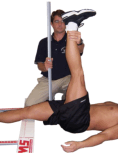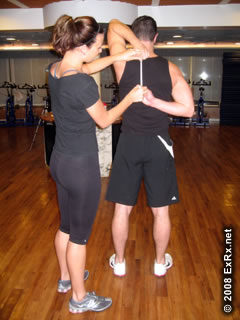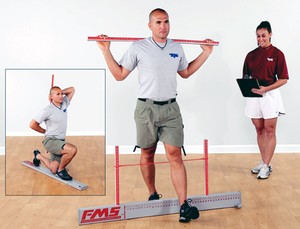Doctors like Janda, Vojta, Lewit and Kolar have made great strides in applying concepts from childhood development to physical rehabilitation of adults. Additionally, Gray Cook and Lee Burton have taken some of these same concepts and applied them in their Functional Movement Screen.
Below are a few notes from developmental kinesiology and what they mean to program design for our clients.
Infant Reflexes
Reflexes are movements that occur automatically (like blinking). While a number of our reflexes occur throughout our entire life, some reflexes are only present when we are babies. These are referred to as infantile reflexes. There are three kinds of infantile reflexes – primitive, postural, and locomotor.
Primitive Reflexes – These are reflexes that deal with an infant producing an involuntary response to specific stimuli. An example of this would be when you place your finger in the palm of a baby; the baby reflexively grasps your finger and squeezes it. Other examples of primitive reflexes are:
- Sucking reflex– brought on by touching the face above or below the lip
- Asymmetrical tonic neck reflex– brought on when the head is turned to one side, causing the same side arm and leg to extend
- Startle reflex – brought on by tapping the abdomen or attempting to startle the infant, causing the arms and legs to flex
- Babinski reflex – brought on by stroking the bottom of the foot from heel to toe, causing the toes to extend
Postural Reflexes – These are reflexes that allow the infant to automatically adapt their posture to changes in environment. These are also referred to as gravitational reflexes, as aside from the derotative righting reflex (which occurs in a supine position), the other reflexes in this category pertain to the baby being supported upright, sitting, or being lowered towards the floor, and how the infant reflexes prepares for different situations in these postures. Some examples of postural reflexes are:
- Derotative righting – In supine, if the infant turns their legs and pelvis towards one side, the trunk and head will follow the rotation. Similarly, if the head is turned towards one side, the body follows the head in that rotation. This occurs around four months of age.
- Labyrinthe righting – When the infant is supported upright, if you tilt the infant, they will reflexively move the head to stay upright
- Parachute Reflex – While holding the infant upright, if you lower them towards the floor rapidly, their legs will extend reflexively in preparation for landing. If you tilt the baby forward, sideways, or backwards, their arms will reflexively extend.
Locomotor Reflexes – As the name implies, these reflexes have to do with our movement. There are three reflexes that make up this category:crawling, stepping, and swimming (Remember those evil moms that you would see throwing their infants into the swimming pool for swim lessons? It turns out…babies could swim!)
 I hope those babies don’t plan on peeing in the pool!
I hope those babies don’t plan on peeing in the pool!
What does this all mean to training adults?
As we develop, these reflexive movements start to become more refined, coordinated and complex, ultimately leading to the specific movements we produce later in life – walking, running, jumping, reaching, grasping, etc.
However, developing these skills does not just happen magically. Learning to control the body and developing fundamental skills make up our motor milestones. Each of these milestones marks a turning point in our development and there is a progression that these milestones follow. In simplistic terms, we need to be able to lift our head and support it, roll over, crawl and creep, support ourselves upright, walk with assistance, and then walk without support.
We can draw many parallels between motor milestones and theFunctional Movement Screen and the way we develop training progressions for our clients.
The Functional Movement Screen and Evaluation of Primitive Movements
The Functional Movement Screen evaluates seven basic movement patterns, and those patterns are then graded on a 1-3 scale as far as the quality of movement being produced, with a score of 0 meaning that the client experienced pain during the movement. The seven tests are:
- Overhead Deep Squat
- Hurdle Step
- Inline Lunge
- Shoulder Mobility
- Active Straight Leg Raise
- Trunk Stability Push Up
- Rotary Stability
At first glance the, it looks like a series of movement tests (which is it). The first three tests are looking at large global patterns and basically evaluating how well the joints of the body, both mobility and stability, play with each other. Tests four and five can be considered mobility tests, as they evaluate what kind of range of motion we can move through at specific areas of our body, and the last two are stability tests, which look at how well we stabilize ourselves.
If I re-arrange the order of these tests to represent our motor milestones, suddenly the movement screen will look very different:
- Active Straight Leg Raise
- Shoulder Mobility
- Rotary Stability
- Trunk Stability Push Up
- Overhead Deep Squat
- Hurdle Step
- Inline Lunge
The tests are now in an order that represents our movement milestones.
The first test, Active Straight Leg Raise, represents the spontaneous movement of supine kicking that we display as infants. When lied on their back, infants will raise their legs up and kick them back and forth. Additionally, at a young age, babies lie on their backs and play with their toes, which incorporates both hip flexion (Active Straight Leg Raise)and shoulder/arm movement (Shoulder Mobility). Furthermore, theShoulder Mobility test looks not only at shoulder mobility, but really how well the thoracic spine functions, as limitations in thoracic extension will surely lead to a poor score in this test.



Creeping and Crawling patterns are the first ways that the infant actually moves around. Creeping is the infants first attempt at crawling and can be viewed as a crawl except the infant is moving close to the ground – belly on the ground – similar to a combat crawl. Crawling is the progression from creeping, where the infant is now moving on their hands and knees. Before the infant can get to a creeping or crawling position, they must first be able to roll over. The Rotary Stability Test not only evaluates the individuals stability in a quadruped (all fours) position, but also tests the individuals rotational stability, which would be needed to perform a proper roll from supine (face up) to prone (face down), which is part of our infantile reflexes. The Trunk Stability Push Up is a representation of the infant pushing itself up in preparation for standing and upright posture.



The Overhead Deep Squat would represent the infant’s ability to stand up without help. As a continuation of the two previous tests, this is in line with our motor milestones as the child first rolls over and crawls (rotary stability), then pushes itself up onto the couch (trunk stability push up), and finally transitions to standing (Overhead Deep Squat).


The Hurdle Step is next in the progression as it represents us actually taking a step and how well we can establish single-leg stance. After taking that first step, we typically fall and catch ourselves, and prepare to stand up again (Inline Lunge).

Rolling Assessment
Another important evaluation that can be used in the Functional Movement Screen is the multi segmental rolling pattern, where the client is asked to roll them self from both supine to prone and prone to supine using only their upper or lower extremity. Multi segmental rolling is an evaluation of the pattern of rolling over, which is the part of the derotative righting reflex discussed above. This tests gives us an appreciation for both stability and mobility of the client, as limitations in mobility will lead to the individual attempting to draw stability from somewhere else in order to complete the movement and appease the tester….after all, you asked them to roll over! Basically, they are going to try and get there anyway they can.
What About Exercise?
Our training progressions should represent these motor milestones, as people need to master the more primitive positions before moving on to more coordinated/skilled movements. Essentially, we want to “fill in the blanks” so that our brain can give our body good feedback about how to appropriately move – you did it once before as a developing infant, and you just need to remember how to do it again!
The goal of correcting movements from the screen should take a similar approach to our motor milestones. Before trying to correct the squat, you would want to first correct the things that came before it, as they would be considered “more primitive”.
The exercises that we prescribe to clients can follow a similar sequence of regression and progression. Here is an example of this sequence for a chop:
- Tall kneeling would be more primitive than half kneeling, so we could start there.
- Half kneeling would come next as this would alter the clients base of support and make them feel less stable.
- A half kneeling chop would be followed by a parallel stance standing chop.
- Parallel stance standing would be followed by an inline stance standing chop.
- Finally we could progress to a single leg chop.
Conclusion
All of a sudden, training clients looks a lot different!
It isn’t about what exercises we do but what we are actually getting when we perform them that is important. Having progressions and regressions of exercises that follow the motor developmental sequence can be an effective way to help your clients get the most out of their training.
*Special thanks to Charlie Weingroff for his editing of this article*
